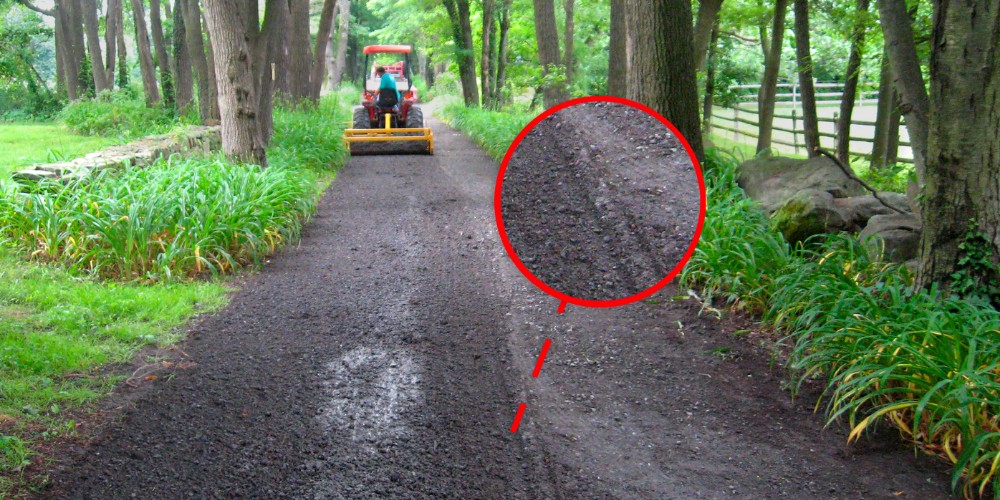You know that feeling when spring rains turn your gravel driveway into a muddy mess—or when every vehicle that drives through just makes the ruts deeper? That’s when you realize: a good crown isn’t optional—it’s essential.
At Roadrunner Equipment, we build skid steer and tractor grader attachments designed to make crowning easy, efficient, and long-lasting. In this post, we’ll show you what crowning is, why it matters, and how to do it right—step by step.
Don’t Have Time to Read? Here’s a Summary
A well-shaped gravel driveway crown is the secret to preventing puddles, ruts, and costly repairs. The crown—a gentle rise in the center—lets water drain evenly off both sides instead of pooling and softening the surface. Without it, gravel shifts, potholes form, and maintenance costs climb.
Why It Matters:
A properly crowned driveway keeps water moving, reduces erosion, prevents potholes, and even makes snow removal easier—all while extending the life of your surface.
How to Crown Your Driveway:
- Break Up the Surface: Loosen compacted gravel with a skid steer or tractor grader.
- Build the Crown: Pull gravel from both sides toward the center to form a ridge.
- Check the Slope: About ½ inch per foot of driveway width (2½” rise on a 10-ft lane).
- Add Gravel: Fill thin spots or eroded areas.
- Compact It: Roll or grade over the surface to lock in shape.
Pro Tip: Grade after a light rain—slightly damp gravel compacts best.
Roadrunner Equipment graders feature adjustable dual blades for smooth, consistent crowning—helping you keep your driveway durable, well-drained, and maintenance-free year-round.
Why Crowning Your Gravel Driveway Matters
The “crown” is the slightly raised centerline that runs down the middle of your driveway or lane. From that center point, the surface slopes gently down toward both sides, allowing rainwater to drain away instead of pooling or soaking through the gravel.
Without a proper crown, water collects in low spots, forming puddles that soften the surface and lead to ruts and potholes. Over time, you’ll lose gravel, create uneven driving conditions, and spend more time (and money) fixing it.
A well-crowned driveway, on the other hand, sheds water quickly—keeping the surface firm, smooth, and stable through every season. It also:
-
Reduces gravel loss through erosion
-
Prevents potholes from forming
-
Makes snow removal easier in the winter
-
Extends the life of your driveway
How to Crown a Gravel Driveway
Even if your driveway was built with a perfect crown, it naturally wears down over time. Rain, snow, plows, and everyday traffic gradually flatten the surface. To keep your driveway in top condition, you’ll want to re-crown it once or twice a year, depending on traffic and weather.
Here’s how to do it right:
Step 1: Break Up the Surface
Use a tractor or skid steer grader to make several passes up and down your driveway. This loosens the top layer of gravel and smooths out ruts or compacted areas.
Step 2: Build the Crown
Starting on one side, pull gravel toward the center of the driveway to create a slight ridge. Then, turn around and repeat from the other side. You’ll see the high point start to form in the middle—that’s your crown.
Step 3: Check the Slope
A good rule of thumb: your crown should rise about ½ inch per foot of width. So, if your driveway is 10 feet wide, the center should be about 2½ inches higher than the edges.
Step 4: Add Gravel (If Needed)
If certain areas look sparse or thin, add fresh gravel to even things out. Focus on sections where traffic or rain tends to wash material away.
Step 5: Compact the Surface
Once the pitch looks right, make several passes with a roller, tractor, or skid steer to compact the gravel. Compacting locks everything in place so the crown holds its shape longer.
Our Recommended Graders for Crowning
When it comes to crowning, the right tool makes all the difference. We recommend a grader with adjustable cutting depth on both sides so you can fine-tune the slope as you go.
That’s exactly how we’ve built our Roadrunner Equipment graders. Our attachments feature a dual-blade configuration that eliminates washboarding and prevents windrows of displaced gravel—giving you a smooth, even finish every time.
Pro Tip: Grade after a light rain if you can. Slightly damp gravel compacts better and helps your crown hold its shape.
Common Crowning Mistakes to Avoid
Even seasoned operators make these simple mistakes from time to time:
-
Over-crowning the center (too steep can cause gravel to wash off the sides)
-
Neglecting compaction after grading
-
Forgetting to clear nearby ditches or culverts
-
Using uneven blade angles that create high or low patches
A few extra minutes of attention here will save you hours of maintenance later.
Keep Standing Water—and Potholes—Away for Good
If you follow these steps, the cross-section of your driveway will look like a soft, A-shaped peak. That subtle shape is what keeps standing water to a minimum and your gravel lane performing well year-round.
Whether you’re maintaining a long farm road or a short residential lane, our graders make it simple to create and maintain the perfect crown.
Ready to improve your gravel driveway?
Check out our skid steer and tractor grader attachments or contact us today — we’ll help you choose the right setup for your property.

